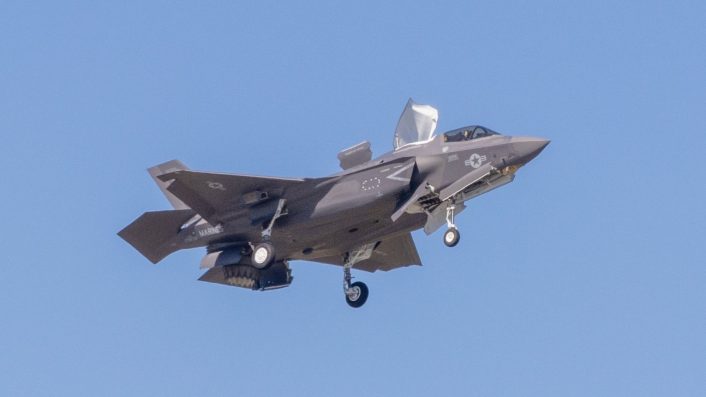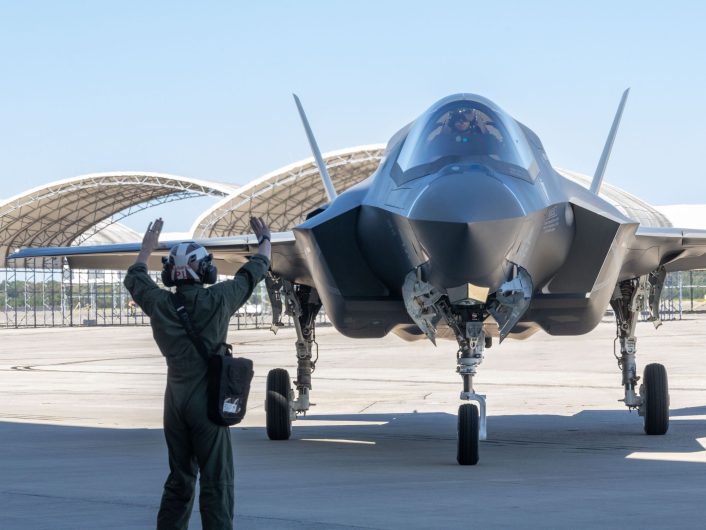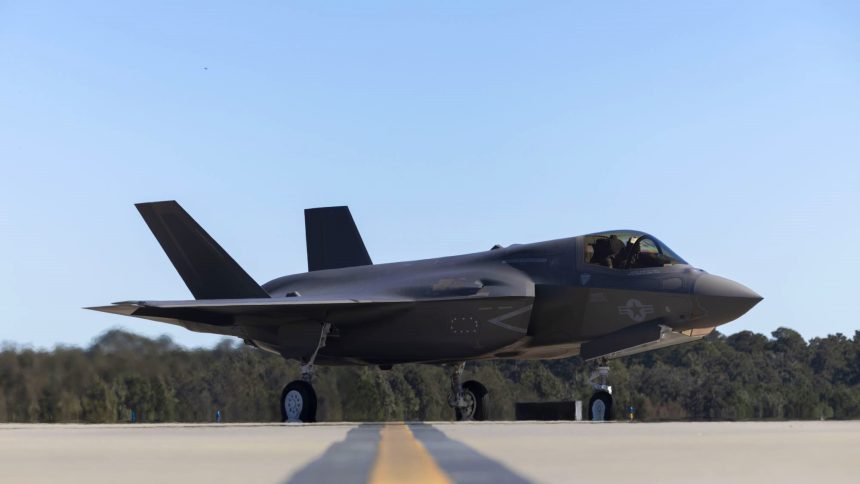The delivery makes VMFA-533 the Marine Corps’ second operational F-35B Lightning II unit on the East Coast. TR-3 supported Block 4 F-35s offer better electronic warfare and target recognition capabilities.
The U.S. Marine Corps’ fighter squadrons are rapidly receiving their F-35s and transitioning from their older F/A-18C/D Hornets. The Marine Fighter Attack Squadron (VMFA) 533, part of the 2nd Marine Aircraft Wing (MAW), received its first F-35B Lightning II STOVL (Short Take-Off Vertical Landing), a Block 4 series aircraft, at Marine Corps Air Station (MCAS) Beaufort, South Carolina, on Oct. 11, 2024. The unit also became the first operational F-35 squadron in Beaufort.
Before this jet’s arrival, the only F-35 aircraft at Beaufort were assigned to Marine Fighter Attack Training Squadron (VMFAT) 501, the type’s Fleet Replacement Squadron involved in “core introduction/fighter attack training for prospective F-35 pilots,” the statement said. The delivery also makes VMFA-533 the Marine Corps’ second operational F-35B Lightning II unit on the East Coast.
Moreover, VMFA-533 also became the second unit in a span of nearly one month to acquire the stealth jet, after VMFA-251 at MCAS Cherry Point, North Carolina, received its first F-35C carrier-capable jet on Sep. 17. Both units are a part of 2nd MAW, which is undergoing the operational transition from legacy fixed-wing tactical aircraft to the fifth generation stealth jet.
The release also stated the capabilities of the F-35 TR-3 (Technology Refresh-3) Block 4 and quoted the USMC officers expressing their satisfaction to witness the arrival of the advanced jet after a year of preparation. While the release did not explicitly state that the F-35B received is in the TR-3 configuration, it should be noted that the hardware and software associated with it are the backbone required for the Block 4.
Marine Fighter Attack Squadron (VMFA) 533 in Beaufort, South Carolina received their first F-35B Lightning II jet, marking their transition from the F/A-18 Hornet to the F-35B. Oct 11, 2024. pic.twitter.com/346qJ4gXqT
— Virtual Bayonet (@VirtualBayonet) October 11, 2024
TR-3, in fact, is needed for the integration of newer weapons, sensors, data processing and target acquisition and identification capabilities as part of Block 4. On Jul. 19, 2024, the F-35 JPO (Joint Program Office) and Lockheed Martin announced the deliveries of the first two TR-3 configured F-35As at Dannelly Airfield, Alabama, and Nellis AFB, Nevada. Issues with the TR-3 led to an interim plan to deliver F-35s with a truncated version of the software, which will be later retrofitted.
F-35B reaches MCAS Beaufort
The officially released video showed the fighter, piloted by VMFA-533’s Commanding Officer, Lt. Col. Zachary Harnett, flying over the base and then performing a vertical landing on the runway. The fighter did not have yet the unit’s insignia, with only the serial number 170533 on the tail, in the usual position below the horizontal stabilizer, and clean vertical stabilizers. The F-35 was greeted by awaiting base personnel and their families on the apron outside the hangar.
“Today’s arrival continues 2nd MAW’s operational transition from legacy fixed-wing tactical aircraft to the F-35,” the statement added. The USMC described the F-35 as a “fifth-generation fighter jet with advanced stealth, agility and maneuverability, sensor and information fusion” that “provides the pilot with real-time access to battlespace information.”

“It is designed to meet an advanced threat while improving lethality, survivability, and supportability,” added the release. ”The F-35B Lightning II is the short-takeoff and vertical-landing (STOVL) F-35 variant. This capability allows the aircraft to operate from amphibious assault ships and expeditionary airstrips less than 2,000 feet long.”
Commanding officer of MAG-31 (Marine Aircraft Group-31), Col. Michael Cassidy, said that the delivery of VMFA-533’s first Block 4 F-35B marks “another chapter” in the squadron’s “storied history that began almost 81 years ago.” It “is a major stepping stone to increasing the lethality of MAG-31 and our ability to contribute to the Marine Air-Ground Task Force and joint force,” he added.
VMFA-533’s illustrious history
The squadron was commissioned on Oct. 1, 1943, as the VMF[N]-533 (Marine Night Fighter Squadron 533) and initially flew the Grumman F-6F-5N Hellcat with the APS-3 radar, then the F7F-73N Tigercat, the F2H-A4 Banshee by May 1953, the F9F Cougar in 1957 and the A-4D Skyhawk in 1959. By this time it was redesignated the VMA-533 (Marine Attack Squadron 533).
Three UMC F-35B Lightning II Joint Strike Fighters with Marine Fighter Attack Squadron 121, 3rd Marine Aircraft Wing, fly over eastern California. (usmc thorn) pic.twitter.com/VxlL4qzdKX
— J.J. (@kadonkey) June 19, 2024
The next airframe change was in 1965, when the squadron received the all weather A-6A Intruder, and a corresponding redesignation to VMA(AW)-533. On Sep. 1, 1992, it then transitioned to the F/A-18D Hornet and relocated to MCAS Beaufort, South Carolina. The squadron is colloquially known as “America’s Squadron” among the squadrons at MCAS Beaufort due to its red, white, and blue insignia.
On Sep. 28, 2023, the squadron was once again redesignated as the VMFA-533, marking the conclusion of its 31 years as a F/A-18 Hornet unit. It then commenced preparations to operate the F-35 stealth jet and received its “Safe for Flight” certification. “Transitioning a squadron is no small feat, and significant preparation by VMFA-533’s Marines and Sailors has occurred over the past year to get them to this point,” Col. Cassidy said.

F-35B TR-3 Block 4 upgrades
The release added that the F-35’s Block 4 upgrades provide enhanced and upgraded weapons carriage capability, advanced non-kinetic electronic warfare capabilities, sensor fusion, data processing and improved target recognition. TR-3 enables Block 4 with “open mission systems architecture, greater computing power, enhancements to the panoramic cockpit display, and a larger memory unit,” added the USMC.
However, the TR-3 software had encountered a series of problems and was delayed by a full year from its original deadline of Apr. 2023, until the first two deliveries in July. Because of this, the cost had overshot by $1 billion. GAO (Government Accountability Office) reports said the TR-3 was unable to support the F-35’s radar and EW capabilities, as its early versions were experiencing rebooting issues and were generally unstable.
US Marine Corps F-35B aircraft attached to Marine Fighter Attack Squadron (VMFA) 225, 15th Marine Expeditionary Unit, prepare to land aboard the amphibious assault ship USS Boxer (LHD 4) while conducting carrier qualifications, Jan. 11, 2023.
(📸/USMC photo by Cpl. Joseph Helms) pic.twitter.com/6fxFWylXnM
— Guy Plopsky (@GuyPlopsky) February 10, 2024
The Pentagon had therefore stopped accepting the deliveries before tests were complete, while the F-35 JPO, Lockheed Martin and the DoD agreed to accept F-35s with an interim, maintainable version of the TR-3. The DoD calculated that the “truncated” version would at least provide part of the capabilities needed for the high-end war before peer competitors. It is not known whether the F-35B landing at MCAS Beaufort is with the truncated or the full version of the TR-3.
“This arrival marks the new era in the Marine Corps’ employment of the F-35. The year-long process of preparing for our first Block 4 F-35 demonstrates the patience and perseverance of the Marines in this squadron,” Lt. Col. Hartnett said.









